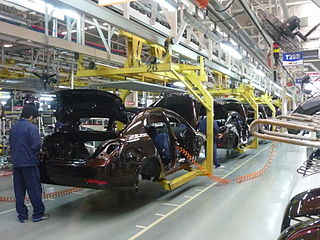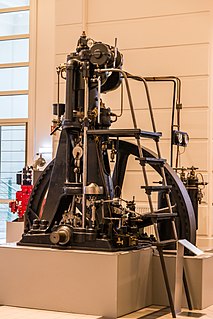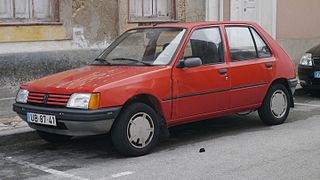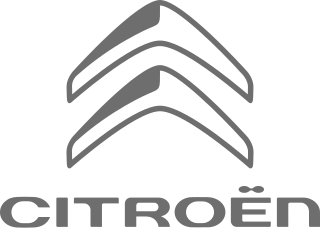
The Ford Orion was a small family car that was produced by Ford Europe from 1983-1993. A total of 3,534,239 units were sold during the car's ten-year production life.
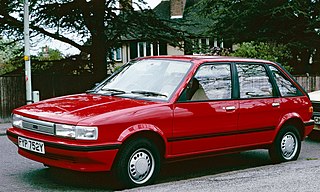
The Austin Maestro is a five-door hatchback small family car that was produced from 1982 to 1987 by British Leyland, and from 1988 until 1994 by Rover Group. The car was produced at Morris' former Oxford plant, also known as Cowley. Today, the redeveloped factory produces the BMW Mini. An MG-branded performance version was sold as the MG Maestro from 1983 until 1991. Although later models were sometimes referred to as the Rover Maestro, the model never wore the Rover badge. A three-box (non-hatchback) car, the Montego, was a derivative of the Maestro.

The Renault Laguna is a large family car by European standards, and was produced by the French manufacturer Renault from 1993 to 2015. The first Laguna was launched in 1994, the second generation was launched in 2000, and the third generation was launched in October 2007.
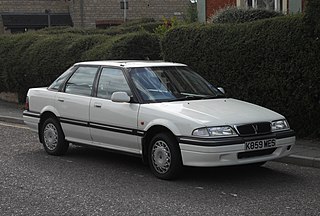
The Rover 400 Series, and later the Rover 45, are a series of small family cars that were produced by the British manufacturer Rover from 1990 to 2005. The car was mutually developed during Rover's collaboration with Honda; the first generation 400 was co developed with the Honda Concerto, and the Mark II 400 being based on the Honda Domani/Civic.
1980 in motoring deals with developments in the automotive industry that occurred in 1980, listed by country. The automotive industry designs, develops, manufactures, markets, and sells motor vehicles.
1981 in motoring deals with developments in the automotive industry that occurred in 1981, listed by country. The automotive industry designs, develops, manufactures, markets, and sells motor vehicles.
1982 in motoring includes developments in the automotive industry throughout the year 1982 by various automobile manufacturers, grouped by country.
This article 1983 in motoring deals with developments in the automotive industry throughout the year 1983 by various automobile manufacturers, grouped by country. The automotive industry designs, develops, manufactures, markets, and sells motor vehicles, and is one of the Earth's most important economic sectors by revenue.
This article 1984 in motoring deals with developments in the automotive industry throughout the year 1984 by various automobile manufacturers, grouped by country. The automotive industry designs, develops, manufactures, markets, and sells motor vehicles, and is one of the Earth's most important economic sectors by revenue. The first practical automobile with a petrol engine was built by Karl Benz in 1885 in Mannheim, Germany.
This article 1985 in motoring deals with developments in the automotive industry throughout the year 1985 by various automobile manufacturers, grouped by country. The automotive industry designs, develops, manufactures, markets, and sells motor vehicles, and is one of the Earth's most important economic sectors by revenue. The first practical automobile with a petrol engine was built by Karl Benz in 1885 in Mannheim, Germany.
1988 in motoring includes developments in the automotive industry throughout the year 1988 by various automobile manufacturers, grouped by country. The automotive industry designs, develops, manufactures, markets, and sells motor vehicles.
1989 in motoring includes developments in the automotive industry throughout the year 1989 by various automobile manufacturers, grouped by country. The automotive industry designs, develops, manufactures, markets, and sells motor vehicles.
1990 in motoring includes developments in the automotive industry throughout the year 1990 by various automobile manufacturers, grouped by country. The automotive industry designs, develops, manufactures, markets, and sells motor vehicles.
1992 in motoring includes developments in the automotive industry that occurred throughout the year 1992 by various automobile manufacturers, grouped by country. The automotive industry designs, develops, manufactures, markets, and sells motor vehicles.
1994 in motoring includes developments in the automotive industry that occurred throughout the year 1994 by various automobile manufacturers, grouped by country. The automotive industry designs, develops, manufactures, markets, and sells motor vehicles.
1995 in motoring includes developments in the automotive industry that occurred throughout the year 1995 by various automobile manufacturers, grouped by country. The automotive industry designs, develops, manufactures, markets, and sells motor vehicles.
1996 in motoring includes with developments in the automotive industry that occurred throughout the year 1996 by various automobile manufacturers, grouped by country. The automotive industry designs, develops, manufactures, markets, and sells motor vehicles.
1997 in motoring deals with developments in the automotive industry that occurred in 1997, listed by country. The automotive industry designs, develops, manufactures, markets, and sells motor vehicles.
1998 in motoring includes developments in the automotive industry that occurred throughout the year 1998 by various automobile manufacturers, grouped by country. The automotive industry designs, develops, manufactures, markets, and sells motor vehicles.
This article 2000 in motoring deals with developments in the automotive industry that occurred throughout the year 2000 by various automobile manufacturers, grouped by country.
